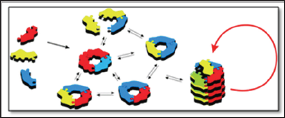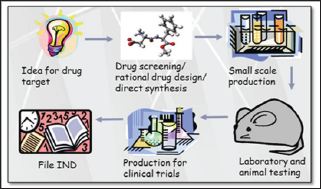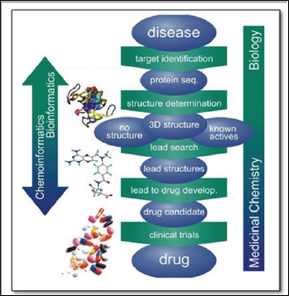Lupine Publishers | Journal of Organic and Inorganic Sciences
Opinion
Figure 1: Example of Combinatorial Chemistry.

Combinatorial chemistry, a new approach for greatly reducing the time for the discovery of newer organic motifs, has been developed over the last few years. Combinatorial chemistry (Figure 1) is a technique for creating huge numbers of biologically potent motif and their hybrids, then rapidly screening them for desirable properties 1. Almost pharmaceutical and agrochemical industries uses this strategy because of the potential for immense reducing in time and cost, and several drug candidates presently in clinical trials are products of this methodology. Drug discovery process (Figure 2 & 3) is long, time and money intensive process [1]. This science of has found application in the production of molecules of commercial interest in the construction of newer pharmacological active therapeutic agents derived from rational drug design, into synthesize complex natural molecules, in the finding innovative approaches to render this chemical science more efficient [2,3]. The development of newer pharmaceuticals is currently a critical and challenging task to the pharmaceutical industry. The vital interest of the medicinal and agrochemical industries in organic synthesis is often related with their natural occurrence. Similarly, medicinal and pharmaceutical field, there has always been and continue to be a need for newer chemical entities with diverse pharmacophoric properties. Many works are still needed to minimize the time, expenditure, and attrition rate in the drug discovery process simultaneously addressing the huge unmet medical need across the world.
Figure 2: Drug development cycle.

Figure 3: Role of Medicinal Chemistry and Biology in Drug Discovery.

Referencing the study report, poor pharmacokinetic and preclinical toxicity were the main reasons for the failure in the drug development, in addition to the lack of efficiency and adverse effects [4,5]. New drugs are necessitated to cure new diseases, to find less hazardous drug and to cure diseases whose drugs have become ineffective due to resistant strains of microorganisms. Besides these causes, new drug discovery and researches are required to recognize pharmacophore present in the effective drugs [6-8]. We must always continue to search for drugs which exhibit clear advantages over the already existing respective drugs. Such advantages may be improvement in bioactivity, partial or total absence of adverse effects, minor toxicity, more nutritive value, improved stability and decrease in production cost. In present, research development department (R&D) of many pharmaceutical laboratories are working for synthesis of newer entities having improved drug activity and increasing yields of existing drugs [9-11]. Combinatorial, medicinal and biological chemistry have contributed to life processes and to the efforts to advance the quality of life as well as to the development of society from synthetic, biopharmaceutical, medical and industrial point of view. Finally, this communication opens the door to the combinatorial design, synthesis of biological active of a variety of newer hybrid molecules.
Acknowledgement
I thankful to chemistry staff members of the Mehesana Urban Institute of Sciences, Ganpat University, Gujarat for support.
Read More About Lupine Publishers Journal of Organic and Inorganic Sciences Please Click on Below Link:
https://lupinepublishers-chemicalsciences.blogspot.com/

No comments:
Post a Comment
Note: only a member of this blog may post a comment.